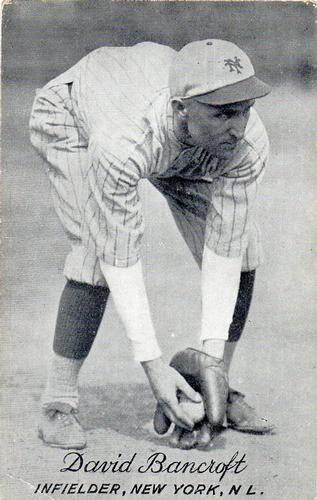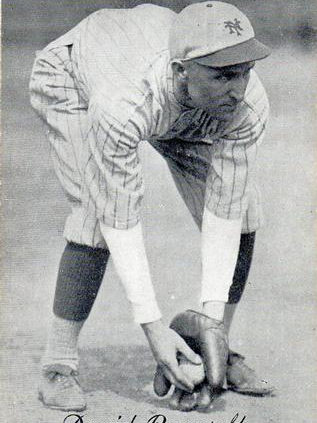June 28, 1920: Dave Bancroft racks up 6-hit game as Giants rout former Phillies teammates
 Dave “Beauty” Bancroft made his name primarily on defense during his Hall of Fame career as a shortstop. One of his biggest days as a hitter came on June 28, 1920, when he went 6-for-6 in the New York Giants’ 18-3 win over the Philadelphia Phillies at the Baker Bowl in Philadelphia. Bancroft’s six-hit game occurred just three weeks after he had been traded from the Phillies to the Giants, ending his six-season run as Philadelphia’s starting shortstop.
Dave “Beauty” Bancroft made his name primarily on defense during his Hall of Fame career as a shortstop. One of his biggest days as a hitter came on June 28, 1920, when he went 6-for-6 in the New York Giants’ 18-3 win over the Philadelphia Phillies at the Baker Bowl in Philadelphia. Bancroft’s six-hit game occurred just three weeks after he had been traded from the Phillies to the Giants, ending his six-season run as Philadelphia’s starting shortstop.
Bancroft made his big-league debut with the Phillies in 1915 and was instrumental in Philadelphia’s winning its first-ever National League pennant that year. He was among the top five National League shortstops in numerous fielding categories over the next five years and legendary Giants manager John McGraw admired him from afar. McGraw suggested to Giants owner Charles Stoneham that he try to acquire Bancroft.
By early June of 1920, Philadelphia was headed for its second straight eighth-place finish in the eight-team NL. The New York Herald reported that Bancroft had asked for a trade after a feud with Phillies manager Gavvy Cravath. They got into a heated argument on May 22 in Chicago after Cravath pulled Bancroft in the middle of that day’s game because Cravath believed Bancroft wasn’t giving his best effort.1
Phillies President William Baker took a train from Philadelphia to New York to meet with Stoneham and they finalized a trade for Bancroft, who was batting .292 through 42 games. The Phillies received shortstop Art Fletcher and $100,000 in the deal, and Bancroft was in a Giants uniform on June 7.
New York had added a sharp-eyed student of the game. In Bancroft’s first game with the Giants, catcher Frank Snyder offered to explain the team’s signs to his new teammate. “Why, have they changed?” asked Bancroft. “If not, I know them already.”2
The June 28 game at the Baker Bowl was Bancroft’s 20th game with New York. The Giants entered with a 28-33 record, while the Phillies were 25-35. The Giants’ starting pitcher was Art Nehf, a lefty from Indiana who later started and won World Series games every year from 1921 through 1924. The Phillies countered with right-hander Lee Meadows, who also went on to pitch in multiple World Series, starting one game each in the 1925 and 1927 fall classics for the Pittsburgh Pirates.
Beginning with shortstop Bancroft hitting second, four consecutive members of McGraw’s lineup eventually made the Hall of Fame. Right fielder Ross Youngs, third baseman Frankie Frisch, and first baseman George “High Pockets” Kelly followed Bancroft, who started his big day in the top of the first by singling and advancing to second on an error by Philadelphia left fielder Irish Meusel.3 Youngs sacrificed Bancroft to third, but he was left there when the scoreless top of the first ended.
The Phillies scored in the bottom of the first on an RBI single by Cy Williams and still led 1-0 when Bancroft came up next in the top of the third. Bancroft singled for his second hit in two at-bats and later scored on Frisch’s three-run home run. The Phillies didn’t score in the bottom of the frame and the Giants led 3-1 after three innings.
The top of the fourth was the Giants’ most productive inning of the day. New York scored seven runs on five hits and three walks. The Giants already had a run in and runners on second and third when Bancroft singled home Earl Smith and Neft to make it 6-1.
Bancroft went to second on a single by Youngs, and the Phillies replaced Meadows with Lefty Weinert. Weinert threw a wild pitch to advance Bancroft and Youngs, and walked Frisch. He then gave up a grand slam to Kelly. It was only the fourth inning, the Giants led 10-1, and Bancroft was 3-for-3 with three singles.
It was still 10-1 when Bancroft led off the top of the sixth with a single to center. It gave him four singles in his first four at-bats. He singled again in the top of the seventh but was caught stealing by Philadelphia catcher Walt Tragesser. Four other Giants scored in the seventh though, moving New York’s lead to 14-1. At the seventh inning stretch, Bancroft was five-for-five with five singles and his new team was crushing his old team.
In the top of the ninth, the switch-hitting Bancroft stepped into the left-handed batter’s box against Phillies right-hander Huck Betts with an opportunity for a baseball rarity – a six-hit game. Only 32 National League batters had compiled six hits in a nine-inning game from 1876 to that point, and nobody had done it in the NL since George Cutshaw of the Brooklyn Dodgers on August 9, 1915.4 Bancroft pulled a single to right field for his sixth hit, all singles, and was replaced by pinch-runner Al Lefevre, playing in his first of only 17 major-league games.
Bancroft was the only NL player with six hits in a nine-inning game in 1920. No NL batter accomplished the feat again until Brooklyn’s Jack Fournier on June 29, 1923. As of August 2024, Bancroft was one of only seven players in Giants history to collect six hits in a nine-inning game.5
The Giants brought in four runs in the top of the ninth, gave up two runs in the bottom of the ninth on a home run by Fletcher, and beat the Phillies 18-3. New York’s 18 runs were tied for the second-most by any NL team in a game that season. Nehf pitched a complete game, allowing nine hits. He didn’t strike out or walk any batters. It was one of Nehf’s 22 complete games that season in 33 starts.
The game took one hour and 50 minutes to complete, and the two-man umpiring staff consisted of Bob Hart behind the plate and Pete Harrison on the bases. Bancroft was busy in the field that day as well; he had four putouts and eight assists, and made a throwing error.
Bancroft’s six-hit feat was featured in newspapers around the country the next day. As one example, the Boston Globe’s headline of the game summary read, “Bancroft’s Six Hits Rare Performance.”6
Robert W. Maxwell of the Philadelphia Evening Public Ledger witnessed the game and wrote, “Dave Bancroft covered himself with glory during the afternoon both in the field and at the plate. … He connected with six safeties in as many times at bat, and you can’t beat that. Six hits in a day is good work in any league.”7
The Philadelphia Inquirer’s Jim Nasium, the pen name of sportswriter and cartoonist Edgar Forrest Wolfe,8 blasted the Phillies’ pitchers in his recap. “They whacked and mauled Lee around the premises until he disappeared in a volley of brutal blows in the fourth period, in which inning the Giants collected seven tallies: then they thumped and abused ‘Lefty’ Weinert until Lefty got out of that and gave the job to ‘Delaware’ Betts, and they kept right on hammering Betts until they had to quit on account of the rules providing that they shall cease hostilities when nine complete innings have been played,” Nasium wrote.9
Bancroft played against the Phillies at Baker Bowl five times in late June 1920. He reached base multiple times in all five games and the Giants won four of them.
It wasn’t surprising that all six of Bancroft’s hits were singles; 1,575 of his 2,004 career hits were singles. He was known as a contact hitter who batted above .300 in five different seasons and struck out only 487 times in 8,250 plate appearances. He was a studious hitter who once said the “business of batting and fielding is a contention between minds.”10 Bancroft was also an outstanding bunter and he had a great eye at the plate, as evidenced by his walking 340 more times than he struck out in his career.11 Sportswriter and official scorer William Hennigan called Bancroft “a timely swatter and a good waiter.”12
The Giants finished 1920 with an 86-68-1 record, in second place, seven games back, while the Phillies finished 62-91, in eighth place in the eight-team NL, 30½ games out of first.
Bancroft led NL shortstops in assists (598), defensive WAR (4.0), double plays (95), fielding percentage (.955), putouts (362), and range factor/game (6.40) in 1920. He helped the Giants reach the World Series every year from 1921 to 1923. They met the American League champion New York Yankees all three years and beat the Yankees in 1921 and 1922.
After 10 more years as a major-league player, including four as player-manager of the Boston Braves (1924-1927), Bancroft hung up his spikes. He was later a coach for the Giants under McGraw and a minor-league manager for teams in Minneapolis, Sioux City, Iowa, and St. Cloud, Minnesota. From 1948 to 1951, he managed teams in the All-American Girls Professional Baseball League in Chicago, South Bend, Indiana, and Battle Creek, Michigan.
He was elected to the Baseball Hall of Fame in 1971 and died one year later.
Acknowledgments
This article was fact-checked by Gary Belleville and copy-edited by Len Levin.
Sources
In addition to the sources cited in the Notes, the author used Baseball-Almanac.com, Baseball-Reference.com, Newspapers.com, and Retrosheet.org.
https://www.baseball-reference.com/boxes/PHI/PHI192006280.shtml
https://www.retrosheet.org/boxesetc/1920/B06280PHI1920.htm
Photo credit: Dave Bancroft, Trading Card Database.
Notes
1 “Bancroft Comes to Giants in Trade for Fletcher,” New York Herald, June 8, 1920: 13.
2 Trey Strecker, “Dave Bancroft,” SABR BioProject, https://sabr.org/bioproj/person/dave-bancroft/. Accessed September 2024.
3 In July 1921 Meusel, one of the NL’s top hitters, followed Bancroft in another controversial trade from the Phillies to the Giants, sparking allegations of collusion between the clubs.
4 Baseball Almanac, “Six Hits in a Game,” https://www.baseball-almanac.com/feats/6_hits_1_game.shtml. Accessed September 2024.
5 The others are Danny Richardson (6/11/1887), Jack Glasscock (9/27/1890), George Davis (8/15/1895), Kip Selbach (6/9/1901), Frisch (9/10/1924), and Jesús Alou (7/10/1964).
6 “Bancroft’s Six Hits Rare Performance,” Boston Globe, June 29, 1920: 7.
7 “Our Phils Lost Everything but the Gate Receipts Yesterday, Says Robert W. Maxwell,” Philadelphia Evening Public Ledger, June 29, 1920: 16.
8 Robert D. Warrington, “The Great Philadelphia Ballpark Riot,” The National Pastime: From Swampoodle to South Philly (Philadelphia, 2013), https://sabr.org/journal/article/the-great-philadelphia-ballpark-riot/.
9 “Giants Bury Phils Under 18-3 Score,” Philadelphia Inquirer, June 29, 1920: 12.
10 Jonathan Weeks, Baseball’s Dynasties and the Players Who Built Them (Lanham, Maryland: Rowman & Littlefield, 2016), 76.
11 Fred Stein, And the Skipper Bats Cleanup (Jefferson, North Carolina: McFarland, 2015), 139.
12 “Five Boston Red Sox on World’s All-Star Baseball Selection,” Winnipeg Tribune, November 9, 1915: 11.
Additional Stats
New York Giants 18
Philadelphia Phillies 3
Baker Bowl
Philadelphia, PA
Box Score + PBP:
Corrections? Additions?
If you can help us improve this game story, contact us.


